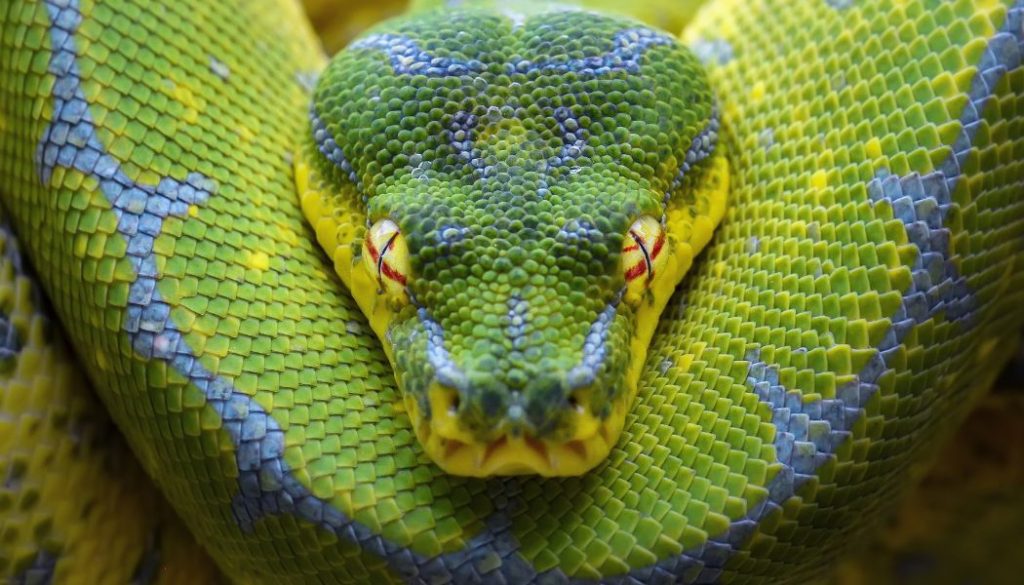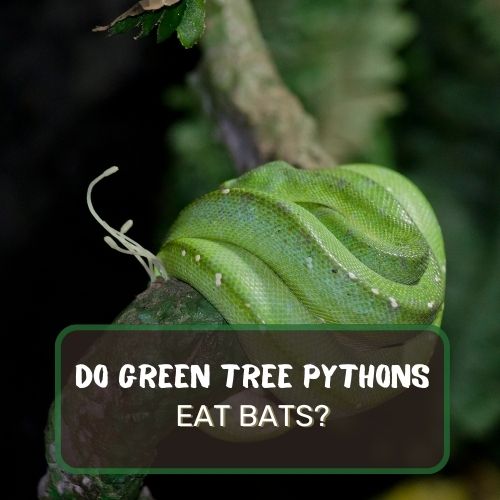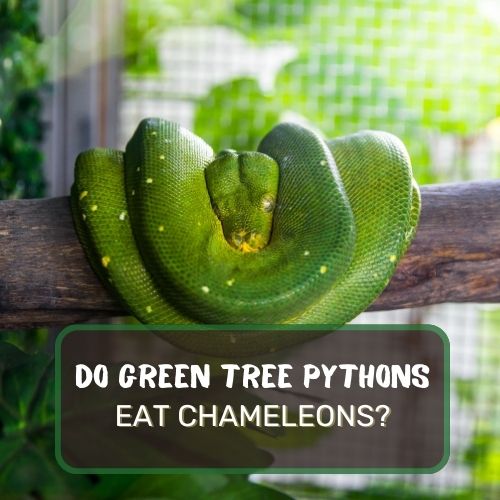Welcome to the ultimate guide exploring that intriguing question: “Do green tree pythons have fangs?”
No, green tree pythons do not have fangs. These captivating reptiles are actually non-venomous and rely on their constricting abilities to subdue prey. What they do have are rows of small, backward-curving teeth designed to grip onto their prey effectively.
So while they might not be equipped with fangs for injecting venom, their teeth still play a critical role in their hunting strategy.
We’re diving deep into the mesmerizing world of snake anatomy, differentiating between fangs and regular teeth, and looking at how other slithering species stack up in the fang game.
We’ll even delve into human interactions and safety tips, so you know what to do if you ever cross paths with one of these fascinating reptiles.
So if you’re a snake aficionado, or just curious, this article has got all the fang-tastic details you’re itching to know!

Table of Contents
The Anatomy of a Snake’s Mouth
So, you’re curious about the inner workings of a snake’s mouth, huh? Let’s dive in, because there’s some fascinating stuff going on in there!
A snake’s mouth is like a well-oiled machine, designed for the specific job of capturing and swallowing prey. Unlike us humans, who use our teeth to chew, snakes need to gulp down their dinner in one piece. Wild, right?
Now, a snake’s mouth is generally composed of the upper and lower jaws, which are incredibly flexible. They can stretch apart to consume prey that’s significantly larger than their own head!
And let’s not forget the teeth. Snakes have these backward-curving teeth that help them hold onto their prey. Once they get a grip, there’s pretty much no escape.
But what about fangs? Oh, fangs are the real game-changers. They’re specialized teeth, typically longer and sharper than the others.
Fangs are the snake’s secret weapon for injecting venom or enzymes into their prey. Imagine a hypodermic needle, but way cooler and all-natural.
Alright, we’ve set the stage. Now let’s get to the nitty-gritty: Do green tree pythons have fangs? Well, you’re just gonna have to read on to find out!
Fangs vs. Teeth: What’s the Difference?
Fangs and teeth are both pointy, but they’re definitely not the same thing! So what sets them apart?
Think of teeth as the multi-purpose tools of the mouth, helping with chewing, biting, and tearing. Pretty versatile, huh? But fangs, oh boy, fangs are the specialists. They have a very specific role, and they excel at it.
Let’s get some perspective. Imagine you’re at a fancy dinner party. Your regular teeth are like the multi-purpose kitchen knife that you use for cutting, chopping, and slicing. It gets the job done, sure.
But fangs? Fangs are like that high-end chef’s knife, designed for a singular, specialized purpose: injecting venom.
Now, not all snakes have fangs. Some make do with just teeth, relying on constriction or other methods to subdue their prey. But the ones that do have fangs? Well, they’ve got a unique edge.
And when we’re talking about green tree pythons, the question on everyone’s mind is: Do they have these specialized fangs, or are they just rocking regular teeth?
To keep the suspense alive, let’s just say they fall into a certain category that might surprise you.
Other Snakes with Fangs
Hold onto your seats because the snake world is full of fang-tastic specimens! Yep, green tree pythons are not the only slithering stars rocking some seriously sharp fangs. Take the rattlesnake, for example.
This bad boy’s fangs can fold back and extend forward when striking, making it a venom-injecting marvel. Or how about the king cobra? When it comes to the fang game, this snake is royalty. A bite from a king cobra can deliver enough venom to take down an elephant!
But hey, not all fanged snakes are lethal giants. Ever heard of the coral snake? It’s small but packs a potent venom, all thanks to those specialized fangs. Even some water snakes have fangs that they use for catching slippery fish.
Now, let’s bring this back to our main event, the green tree python. How does it stack up against these other fanged wonders? Do they join the ranks of these specialized biters, or are they in a league of their own? The answer might just make your jaw drop!
Types of Fangs in Snakes
Okay, so we’ve established that fangs are like the superheroes of the snake world. But did you know there’s more than one type of fang? Yep, it’s not a one-size-fits-all kind of deal. Here’s a quick rundown:
- Solenoglyphous Fangs: These are the foldable fangs you’ll find in vipers and rattlesnakes. They’re super long and can inject venom deep into their prey. It’s like a syringe, but nature-made.
- Proteroglyphous Fangs: Think cobras and coral snakes. These fangs are fixed in place and are relatively short. But don’t underestimate them; they’re more than capable of delivering a lethal dose of venom.
- Opisthoglyphous Fangs: Now, these are rear-fanged snakes. The fangs are situated further back in the mouth and are often used for holding onto prey rather than injecting venom. Examples include the boomslang and some species of colubrids.
So, where do green tree pythons fit into this fangtastic framework? Well, without giving too much away, let’s just say they’ve got a specialized set of tools that make them incredibly effective at what they do.
But to find out exactly what kind of fangs they’re sporting, you’ll have to keep reading!
Human Interaction and Safety Tips
Let’s shift gears for a moment. We’ve been talking a lot about fangs and venom, but what does this mean for us humans?
If you’re out hiking in the woods or even just taking a stroll through a pet store, knowing how to interact with snakes—fanged or otherwise—can make all the difference.
First off, the golden rule: Don’t provoke. Snakes, including the green tree python, are generally more afraid of you than you are of them. If you stumble upon one, maintain a safe distance and give it space to slither away. Chances are, it wants nothing to do with you.
But what if it’s too late and you’ve already been bitten? Well, if it’s a green tree python, you might be in luck.
While we’ll dive into the specifics later, let’s just say that a bite from this python species isn’t usually a life-threatening event. But that doesn’t mean you should be careless!
If you’re bitten by any snake, it’s crucial to seek medical attention ASAP. And for those planning to venture into snake territory, it might be wise to carry a snakebite kit. Trust me, it’s better to be over-prepared than under-prepared.
Conclusion
You’ve just journeyed through the fascinating world of snake anatomy, fangs, and the captivating green tree python. Now you know that while these particular pythons don’t sport fangs, they are incredibly efficient with their specialized teeth.
You’ve also learned about the difference between teeth and fangs and even picked up some safety tips for human-snake interactions.
Knowledge is power, and you’re now better equipped to appreciate the incredible diversity and adaptability of these remarkable reptiles. So go ahead, share your newfound wisdom, and let your curiosity guide you to even more exciting discoveries!
FAQ
You’ve got questions, I’ve got answers! Here are some of the most frequently asked queries about green tree pythons and their chompers:
Do green tree python bites hurt?
A bite from a green tree python can be painful, but it’s usually not life-threatening. Their fangs are designed to grip onto their prey, so you’ll likely feel a sharp pinch. But hey, it’s far from a rattlesnake bite!
Do pythons have teeth or fangs?
Ah, the million-dollar question! Well, spoiler alert: pythons typically have teeth, not fangs. They’re non-venomous and rely on constriction to subdue their prey. That said, their teeth are no joke; they can definitely leave a mark!
How do you know if a snake has fangs?
You could take a peek inside its mouth, but I wouldn’t recommend it! A safer bet is to do your research. Know the types of snakes you might encounter in a particular area and learn about their fang situation beforehand. Trust me, Google is your friend here.
Do baby pythons have fangs?
Baby pythons are born with teeth, just like their adult counterparts. But fangs? Not so much. They use their petite but sharp teeth to grab onto their tiny prey. So, they might be small, but they’ve still got bite!




0 Comments